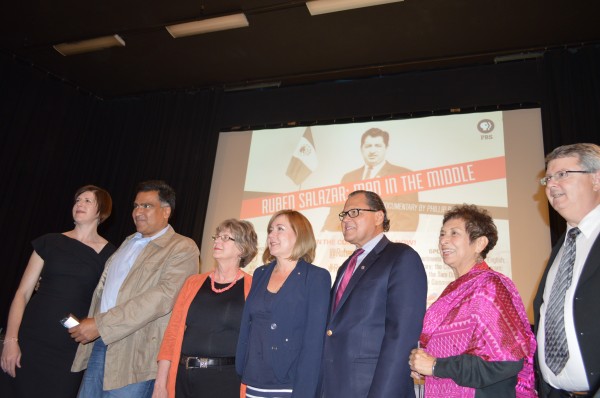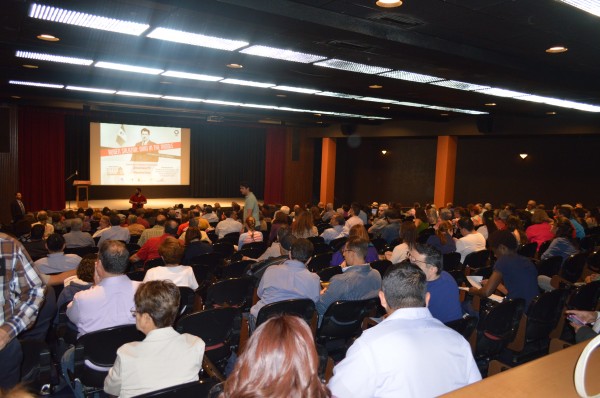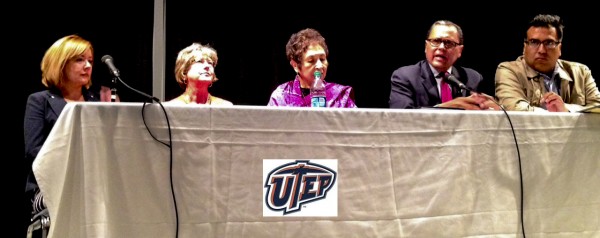
Organizers and panelist of the preview of documentary Rubén Salazar: Man in the Middle. From left to right Dr. Stacey Sowards, chair UTEP Department of Communication, Phillip Rodriguez, Film Director, Zita Arocha, Borderzine Director, Angela Kocherga, Border Bureau Chief, Texas Senator Jose Rodriguez, Rosa Guerrero, Artist and Educator and El Paso Times Editor and panel moderator, Bob Moore. Photo credit: Camilo Jimenez
EL PASO — Exiting the cinema, a teary-eyed and choked-up man in his sixties wearing a white guayabera shirt and a Panama fedorasaid the film he had just finished watching was tragic and reminded him of his days as a Chicano activist in California alongside César Chávez.
The film was Ruben Salazar: Man in the Middle directed by Phillip Rodriguez, which explores the life and tragic death of the legendary Mexican-American journalist.
Salazar was born in the Mexican border town of Cuidad Juárez, but was raised here just across the river. He graduated from El Paso High School and Texas Western College (now the University of Texas at El Paso) before he started working at the El Paso Herald Post as a reporter and eventually at the Los Angeles Times. After leaving the Times, he went into broadcasting at the Spanish language station KMEX.
While working for KMEX, Salazar was covering the Chicano Moratorium March on August 29, 1970, when the demonstration took a violent turn and escalated into a riot, Salazar took cover in a dingy bar called the Silver Dollar. He was killed by a tear gas canister that was fired blindly into the bar by police.
The film explores various conspiracy theories surrounding his death, including the possibility that he was deliberately murdered, perhaps by the L.A.P.D. Shortly after he died, Salazar became a martyred icon to many Chicanos.
Rodriguez, the director, told the audience of some 300 persons that he needed to tell the story of the man, not the icon. “I was aware of him but only as a symbol” said Rodriguez, “but I did have a sneaking suspicion that he was a lot more interesting than the idea of him that I had heard.”

The audience awaits the arrival of director Phillip Rodriguez for the screening of his film Ruben Salazar: Man in the Middle. Photo credit: Camilo Jimenez
Rodriguez also said he knew there was going to be some backlash because he was trying to humanize Salazar. He felt several civil rights “icons” had lost their “mojo” as their stories were retold and this film would refresh his images.
“Whenever you challenge a standing mythology or historicize a religious figure, there are some people that are going to feel uncomfortable, and I suppose that’s to be expected but that’s fine with me,” he said.
Rodriguez and the producers of the film filed a lawsuit against the L.A. County Sheriffs’ department demanding they release the files in this case, which had been closed since Salazar’s death. A study of the files uncovered a secret investigation that was conducted by the U.S. Department of Justice, which ruled Salazar’s death as accidental.
Still, some of the viewers felt that the film lacked some detail and was too biased toward the theory that Salazar’s death was accidental.
“I think they killed him,” said Marco Zamora, a journalism student who attended the film, “it doesn’t make sense that a cop wouldn’t know the difference between the two types of projectiles and would fire a canister into a crowd.”
The film also preceded a discussion panel made up of four prominent Latinos and journalists who along with Rodriguez expressed their feelings about the film and the legacy of Rubén Salazar.
The panelists included Phillip Rodriguez, the film’s director, Zita Arocha, Director of Borderzine, UTEP Department of Communication, Angela Kocherga, Border Bureau Chief, KHOU-TV/Gannett Broadcasting, Rosa Guerrero, artist and educator and Texas Senator Jose Rodriguez.
Throughout the film and the panel, themes of identity, assimilation, and heritage are present and reflect the feelings of some of the attendees and of the filmmakers themselves.
The film touched on the subject of being Mexican-American in the U.S. during that period and Salazar’s struggle with his Mexican roots and an upbringing that tried to turn him away from that heritage. According to the film, he eventually came to terms with his identity and embraced his Latino roots, getting involved in Chicano politics and covering the movement.
Senator Rodriguez touched on his own personal experiences about being Latino and the obstacles he had to overcome growing up in South Texas and on how he felt when he found out that Salazar had been killed.
“I was enraged,” he said, “I was involved in different programs like MECHAand La Raza Unida, and he was someone we looked up to. Then the following year, we had our own incident in Pharr.”

Members of the discussion panel Angela Kocherga, Border Bureau Chief, Zita Arocha, Borderzine Director, Rosa Guerrero, Artist and Educator, Texas Senator Jose Rodriguez, and Phillip Rodriguez, Film Director, touched on several topics especially identity, assimilation and heritage. Photo credit: David Smith
Sen. Rodriguez was referring to the 1971 riots that occurred in Pharr, Texas, where a protest turned violent and a 17-year-old boy was killed.
“It warms my heart seeing young people interested in things like this,” said Rodolfo Jiménez, the man in the white shirt and straw hat, “I’m glad that people are aware of what we went through. People attacked us, spat on us, threatened us, and why, only because we wanted a better life. We’ve come a long way but we still have a long, long way to go. I just hope that all these young people pick up where we left off.”
The film Ruben Salazar: Man in the Middle, will air on PBS on April 29, 2014 at 9 p.m.

